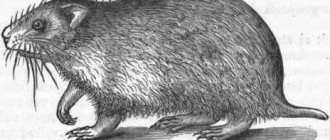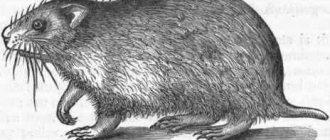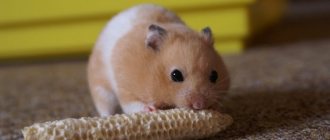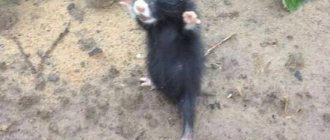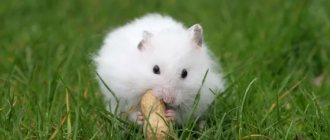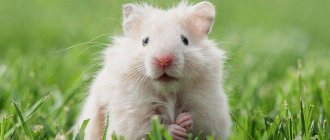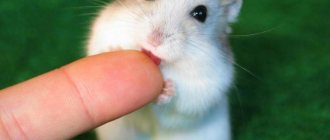Hamster
If you are asked to impersonate a hamster, the first thing you will probably do is puff out your cheeks.
Why does this rodent with small ears and a short tail have such large cheeks? The fact is that hamsters have very developed cheek pouches. For example, a common hamster can store up to 46 grams of wheat in them, and with the help of its prominent cheeks it can store up to 90 kilograms of food. Hamsters are different, even long-haired and curly. Syrian hamsters are usually kept at home.
The Vietnamese authorities have banned the keeping of hamsters, considering them carriers of dangerous diseases. But Chinese hamsters are valued all over the world, as they benefit humanity. They secrete a substance from which Rebif is made, a drug used to treat multiple sclerosis.
How a hamster hides food behind its cheeks
The rodent picks up food with its paws and puts it in its mouth. First, he stuffs one muscle bag, which opens from the inside and stretches under the pressure of food, then he does the same with the second. Immediately after performing these manipulations, the animal, waddling, follows to a secluded place where it leaves the food it has stored. To free the muscle cavities from supplies, the hamster presses on its chubby cheeks with its paws. As a result, the food spills out and the tissue returns to its original state. After this, the animal goes for a new portion of food.
British cat
The round, well-developed cheeks of a British cat are one of the main distinguishing features of the breed. It’s not surprising that every owner of a “British dog” dreams of his pet having wow cheeks! There is an opinion among people that you can “eat” your cheeks - you just need to know what, even all sorts of recipes are offered.
But the presence or absence of expressive cheeks is purely genetic, like tail length or coat texture. That’s how nature decreed it – you either have cheeks or you don’t. There are no special diets that would help enlarge the cheeks. As in the fairy tale about Cinderella: “No connections will help you make your legs small, your soul big, and your heart fair.”
Tumors
Cheek pouch tumors are another common problem in pet hamsters. The tumors are usually malignant and usually affect only one of the sacs. They can penetrate the entire tissue of the cheek pouch, which extends to the shoulders.
Packed tumors are usually hard and do not feel like a bag filled with food. These tumors (usually squamous cell carcinoma) worsen the prognosis for the hamster and are difficult, if not impossible, to remove completely while still allowing the hamster to eat normally.
Chipmunk
Chipmunks can carry up to nine nuts on their cheeks at a time. They, like hamsters, have cheek pouches that serve to collect, temporarily store and transport collected food for further consumption in a secluded place. Chipmunks can be hand trained. The natural ability of the animal to make reserves is very helpful in this matter. This instinct forces him to make contact with the person who offers him food. Fear of a person turns out to be much less than the food instinct, therefore, with frequent feeding from hands, the chipmunk ceases to regard the person as its enemy and adapts to it. Chipmunks are graceful, trusting, and clean. Chipmunks are popular. Their big cheeks can be seen in the comedy Alvin and the Chipmunks and in the animated series Chip 'n' Dale Rescue Rangers.
“Nuts? no, I didn’t see it!”
The purpose of cheek pouches in rodents
Wild hamsters need them to survive. The animals feed on small grains that are difficult to transport into burrows. Thanks to its huge cheeks, the rodent can make reserves. He fills the free space with food and carries it into the hole. The cheek pouches contain enough food to last the animal for a day.
Thanks to the habit of stuffing grains into its mouth, a pet can survive if it finds itself in a difficult situation. For example, when escaping from a predator, if the lair is far away.
Thanks to the supplies in the pantry, the animal easily endures hibernation. In winter, all life processes of a hamster slow down. He is in a daze and wakes up once a week to eat and relieve himself. This allows the pet to survive the cold season for which it is not adapted.
Bubble Eye
Bubble eyes "water eyes" are one of the artificially cultivated breeds of aquarium "goldfish". He has large eyes and ocular vesicles filled with fluid. They hang down on both sides of the head, which is why many people call them cheeks. Sometimes the bubbles reach the size of up to a quarter of the fish’s body. Because of this unusual structure, the eyes often suffer, they are easily damaged, often they simply fall off, but are capable of regeneration within three to four weeks.
6 funny animals with big lips >>>
Unpopular breeds or wild hamsters
Most wild hamsters are nocturnal and go into short-term hibernation in winter. They feed on both plant and animal foods, preferring products from their habitat. Many of them build holes, breaking through long labyrinths; small individuals use other people's homes.
Common hamster (karbysh)
A wild hamster can reach a size of 34 cm, and the length of its tail is 3-8 cm. It lives in steppes and forest-steppes, often settling near humans. Its skin is bright: the back is reddish-brown, and the belly is black. There are white spots on the sides and front. There are black specimens and black ones with white spots. Karbysh live in the wild for 4 years, and in favorable conditions they can reach 6 years.
Common hamster
Gray hamster
The gray hamster is a rodent, no larger than a mouse. it belongs to the genus of gray hamsters. The body length is from 9.5 to 13 cm. It has a gray back and a light belly. Depending on the habitat, the color of the skin may change. He doesn’t dig holes himself, but takes other people’s. The animal has large cheek pouches and small ears. In some regions it is listed in the Red Book.
Gray hamster
Hamster Radde
The Radde hamster is found in the foothills and mountainous areas and prefers plant foods. It multiplies rapidly and destroys the grass, which angers farmers. The animal reaches a size of 28 cm and weighs more than 700 g. There are individuals weighing about 1 kg. The rodent's skin is silky: brown on top and dark below with reddish “inserts”. There are white spots along the face and behind the ears. In the wild, the animal lives for about 3 years.
Hamster Radde
Eversmann's hamster and Mongolian hamster
The genus of Eversmann's hamsters includes two rodents that are similar in appearance and habits: Mongolian and Eversmann. Both animals prefer steppes and semi-deserts. The Mongolian lives in the deserts of the country, northern China and Tuva.
Mongolian hamster
Both animals are no more than 16 cm in size with a short tail of 2 cm. The Mongolian is slightly smaller, the color of its back is lighter and there is no characteristic dark spot on the chest, like the Eversmann hamster. The Eversmann hamster may have an intensely colored back, brown, black or golden. Both hamsters have a light belly and legs. They are listed in the Red Book.
Eversman's hamster
Barabinsky hamster
The animal belongs to the genus of gray hamsters. Lives in Western Siberia, Transbaikalia, Mongolia. The body length is up to 12-13 cm, the tail is about 3 cm. The rodent is dressed in a red fur coat and there is a black stripe along the back: from clear to blurred in different individuals. The abdomen is light to white. A characteristic feature is two-color ears with a white border along the edges. There are 4 types of hamsters.
Barabinsky hamster
Daurian hamster
The Daurian hamster is a variety of the Barabensis (Cricetulus barabensis Pallas). Lives in Western Siberia. The color of the back is darker than that of other subspecies. A clear stripe is noticeable on the back.
Daurian hamster
Brandt's hamster
Belongs to the genus of medium-sized hamsters. The size of the individual is from 15 to 18 cm, the tail length is 2-3 cm, it weighs 300 g. It lives in the foothill steppes of Transcaucasia, Turkey and Lebanon. The color of the back is brown, the belly is white or gray. The animal has a dark spot on its chest. There is a double white stripe running along the neck around the head, which starts from the mouth and ends near the ears. There are light spots on the cheeks. Lives for about 2 years.
Brandt's hamster
Hamster Sokolov
Little-studied representatives of the genus of gray hamsters. They live in Mongolia and China. Unlike many other members of the family, they do not harm cereal crops. The size of the animal is about 11.5 mm. He has a gray skin and a light belly. The hamster's tail is almost invisible. There is a dark stripe along the back. It will not live long in captivity because there is too little information about it.
Hamster Sokolov
Chinese hamster
The Chinese hamster is named after its habitat. It belongs to the genus of gray hamsters. This is an animal with a slightly elongated body - 8-12 cm and a bare tail. The back of the animal is dark brown with a noticeable stripe. Rodents live on average 2.5 years.
Chinese hamster
Newton's hamster
A bit similar to the “Syrian”, but different in color and character. If the former are peaceful, then “Newton” has an evil disposition. Its size is up to 17 cm, its tail length is up to 2.5 cm. The rodent has gray-brown fur on the back with a black stripe from the head to the middle of the body. The throat and part of the chest are covered with dark fur, and the belly is light.
Newton's hamster
Taylor's Hamster
These hamsters grow no more than 8 cm. Their back is gray-brown and their abdomen is light. They live in Mexico and Arizona. In nature, they use other people's holes or make houses near stones and crevices. They live in dense grass.
grasshopper hamster
The grasshopper or scorpion hamster lives in Canada and Mexico. It grows up to 14 cm, including the tail, its weight is 40-60 g. Its skin is brown, its abdomen is light. The animal feeds only on insects, lizards and small rodents. Species of hamsters like this predator are no longer found. A scorpion can also become its prey. The hamster is resistant to insect venom. These hamsters sometimes squeak for a few seconds while raising their head up. This phenomenon is commonly called the howling of hamsters.
grasshopper hamster
Siberian hamster
The Siberian hamster is distinguished by a seasonal change of coat. This dwarf member of the family wears a dark gray outfit with a brown stripe in summer, and in winter he dresses in a white fur coat with a gray line on the back. The animals grow up to 10 cm, and the maximum weight when kept at home is 50 g. In nature, rodents live 2.5 years, in captivity - up to 3 years.
Siberian hamster
Tibetan hamster
Dwarf Tibetan hamsters live in China. These types of hamsters can live in mountainous areas at altitudes of up to 4000 m above sea level. The animals grow up to 11 cm, with the tail making up almost half the body length. Their color is gray with dark and black veins. The tail is pubescent and has a black stripe running along its surface. The abdomen and underside of the tail are light.
rat hamster
These agricultural pests live in Northern China. The size of the animals is up to 25 cm, the tail grows up to 10 cm. The color of the back is gray-brown, the abdomen is light, the tail is brown, the paws are white, the soles are covered with hair.
rat hamster
Short-tailed hamster
This breed of hamster lives in Tibet and China at an altitude of 4000-5000 m above sea level. Their color is uniform: brown, gray with a yellow tint. With a body length of up to 10 cm, they weigh 40 g.
Canese hamster
A little-studied species. Lives in deciduous forests of China. It feeds on plants and builds nests on the ground. The length of the animal is 17 cm, the tail is 10 cm. The rodent has dense fur, and white claws are visible on its thin paws. The color of the back is gray, there are white spots on the ears and cheeks, and the belly is also white.
Features of loss
Using food with larger particles, particularly large nuts, can lead to loss of cheek pouches. Outwardly, this can be noticed by a foreign object protruding in the corner of the mouth. Often, owners perceive the protruding fragment as a foreign body and try to remove it. You can't do that.
If the sac falls out, the hamster needs qualified help from a specialist. The veterinarian will numb the affected area, and then straighten the pouch that has turned inside out and put it in its usual place. You should contact the clinic as soon as possible. Delay leads to the development of purulent processes. Then the bag is no longer reduced, but removed. After surgery, antibiotic therapy is given. Removing the sac does not affect the pet's quality of life in any way.
How to avoid problems with cheek pouches in a hamster
As you can see, the treatment of the inflammatory process of the cheek pouches and their loss is not very simple. Therefore, it would be much more correct and easier to take the necessary preventive steps that will reduce the likelihood that you will encounter this problem. To do this, do not use mineral, wood cat litter, straw or hay as bedding. Make sure that your hamster's menu does not include large nuts and grains, legumes, or sweets. About fillers for hamsters.
Treatment of inflammation of the cheek pouches in a hamster
Proper care is the key to your hamster's health
. Of course, if you notice that the rodent has stopped eating, is behaving passively, its mouth is slightly open, a lump is palpable in the area of the cheek pouches, or an abscess may form on the cheek, it is better to consult a veterinarian. Who will be able to understand the problem, eliminate hair loss, if any, localize the inflammatory process, and thoroughly rinse the cheek pouches to get rid of foci of infection.
If this is not possible, you will have to act on your own. First of all, you will need to rinse your cheek pouches. If the hamster's cheek breaks out, insert a syringe with a tube or an ordinary miniature medical bulb into the hamster's mouth, and tilting the hamster down a little so that he does not choke on the medicine, rinse the bags with an antibiotic solution based on a 0.5% novocaine solution or a dioxidine solution. The top of the abscess can be treated with peroxide and Vishnevsky ointment applied. After the abscess breaks, apply Levomekol ointment until the wound heals. During treatment, the hamster must be switched to a special diet, excluding solid food from it, and giving only food with a puree consistency.
